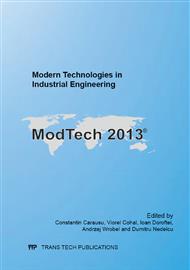[1]
K. Allen: How ESD damage affects OEMs and what they can do to mitigate the damage, PC/104 Embedded Solution (2002).
Google Scholar
[2]
J. Paasi, S. Nurmi, T. Kalliohaka, G. Coletti, F. Gustavino, et al., Electrostatic testing of ESD-protective clothing for electronics industry, Electrostatics 2003 Conference (2003) 239-246.
DOI: 10.1201/9781420034387.sec6
Google Scholar
[3]
G. Schmeer-Lioe, Anwendungsorientierte Prufung des elektrostatischen Verhaltens von Textilien, Technische Textilien 43 (2000) 182.
Google Scholar
[4]
J.N. Chubb, Comments on methods for charge decay measurement, J. Electrostat. 62 (2004) 73-80.
Google Scholar
[5]
M. Cieslak, S. Wrobel, Assessment of Textiles Based on Three Test Methods of Charge Decay Time, 7th International Symposium EL-TEX 2006 (2006) 16-17.
Google Scholar
[6]
F. Marchini, Advanced Applications of Mettalized Fibres for Electrostatic Discharge and Radiation Shielding, J. Ind. Text. 20 (1991) 153-166.
DOI: 10.1177/152808379102000303
Google Scholar
[7]
N. Wilson, The Nature and Incendiary Behaviour of Spark Discharges from Textile Sufraces, J. Electrostat. 16 (1985) 231-245.
DOI: 10.1016/0304-3886(85)90046-4
Google Scholar
[8]
J.L. Davidson, T.J. Williams, A.G. Bailey and G.L. Hearn, Characterisation of electrostatic discharges from insulating surfaces, J. Electrostat 51-52 (2001) 374-480.
DOI: 10.1016/s0304-3886(01)00104-8
Google Scholar
[9]
A.S. Ardeleanu, A. Verejan and C. Donciu, Study Regarding the Knitting Parameters in 3D Textiles Shields Implementation, Acta Electrotehnica 51 (2010) 128-131.
Google Scholar
[10]
G. Baumgartner, Consideration for developing ESD garment specifications, ESD TR 05-00 Report, ESD Association (2000).
Google Scholar
[11]
H.S. Chen, K.C. Lee, J.H. Lin, Electromagnetic and electrostatic shielding properties of co-weaving-knitting fabrics reinforced composites, Compos Part A-Appl. S. 35 (11) (2004) 1249-1256.
DOI: 10.1016/s1359-835x(04)00119-8
Google Scholar
[12]
K.B. Cheng, K.C. Lee, T.H. Ueng, K.J. Mou, Electrical and impact properties of the hybrid knitted inlaid fabric reinforced polypropylene composites, Composites Part A: Applied Science and Manufacturing 33 (9) (2002) 1219-1226.
DOI: 10.1016/s1359-835x(02)00076-3
Google Scholar
[13]
M. Cieslak, S. Wrobel, I. Kaminska and M. Lao, Functional Upholstery Materials for Protection Against Electrostatic Risk, Fibres Text. East. Eur. 17 (2009) 52-58.
Google Scholar
[14]
J.N. Chubb, Tribocharging studies on inhabited cleanroom garments, J. Electrostat. 66 (2008) 531-537.
DOI: 10.1016/j.elstat.2008.06.001
Google Scholar
[15]
K.B. Cheng, T.H. Ueng and G. Dixon, Electrostatic Discharge Properties of Stainless Steel/Polyester Woven Fabrics, Text. Res. J. 71 (2001) 732-738.
DOI: 10.1177/004051750107100813
Google Scholar
[16]
C. Donciu, Core conductive yarn based integral knitted ESD Garments. Part I. Metallic core conductive yarns investigation, 2013 International Conference on Future Energy & Materials Research (2013), Singapore.
DOI: 10.4028/www.scientific.net/amr.772.467
Google Scholar
[17]
C. Donciu, Core conductive yarn based integral knitted ESD Garments. Part II. Carbon composite yarns investigation, 2013 International Conference on Future Energy & Materials Research (2013), Singapore.
DOI: 10.4028/www.scientific.net/amr.772.474
Google Scholar
[18]
Standard EN 1149-5: 2008, Protective clothing - Electrostatic properties - Part 5: Material performance and design requirements (2008).
Google Scholar


